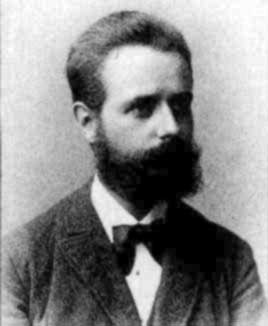
Ernst Heinrich Bruns
 المؤلف:
H-J Ilgauds and G Münzel
المؤلف:
H-J Ilgauds and G Münzel
 المصدر:
Heinrich Bruns, Felix Hausdorff und die Astronomie in Leipzig
المصدر:
Heinrich Bruns, Felix Hausdorff und die Astronomie in Leipzig
 الجزء والصفحة:
...
الجزء والصفحة:
...
 22-1-2017
22-1-2017
 603
603
Born: 4 September 1848 in Berlin, Germany
Died: 23 September 1919 in Leipzig, Germany

Heinrich Bruns's parents were Caroline Henriette Hasse and Christian Gerhard Bruns who was a landscape painter. Bruns studied in Berlin from 1866 to 1871, obtaining a doctorate under Weierstrass and Kummer in 1871 for his thesis De proprietate quadam functionis potentialis corporum homogeneorum. After graduating he was employed as a calculator at the Observatory in Pulkovo, near St Petersburg, Russia. This Observatory was founded in 1839 by Friedrich Georg Wilhelm von Struve who became its first director. The 15-inch refracting telescope installed there in 1839 was the largest in the world, and the observatory had quickly acquired an outstanding reputation for the quality of observations made there. When Bruns worked there the director was Otto Vasiliyevich Struve, son of the first director. At the Pulkovo Observatory Bruns met another calculator, Marie Wilhelmine Schleussner who was two years younger than Bruns, and the two married.
In 1873 Bruns left Pulkovo to take up the position of observer at the Dorpat Observatory (now Tartu, Estonia). Peter Carl Ludwig Schwarz had taken over from Thomas Clausen when he retired as director in the year before Bruns arrived at the Observatory. After three years at Dorpat, Bruns was appointed as Professor of Mathematics at the University of Berlin where he remained until 1882. On leaving Berlin he took up the chair of astronomy in the Philosophy Faculty of the University of Leipzig, becoming director of the Leipzig Observatory. The Observatory, the second at the University of Leipzig, had been built in 1860-1861 at the west edge of the Johannistal. Bruns was the second director, the first being Carl Christian Bruhns who held the position from 1861 until his death in 1881. Bruns held these positions until his death in 1919. His most famous doctoral student at Leipzig was Felix Hausdorff who graduated with his doctorate in 1891 awarded for his thesis Zur Theorie der astronomischen Strahlenbrechung which studied refraction and extinction of light in the atmosphere.
Bruns was interested in astronomy, mathematics and geodesy. He worked on the three-body problem showing that the series solutions of the Lagrange equations can change between convergent to divergent for small perturbations of the constants on which the coefficients of the time depend. The three-body problem was one of major importance to both mathematicians and astronomers. The Earth-Moon-Sun system was the most important astronomical applications for here none of the gravitational forces could be ignored. Energy and angular momentum are conserved in a three-body system but it was hoped that other quantities, such as the integrals of the motion, might be conserved. Bruns showed in 1887 that there could be no conserved quantities which could be expressible as algebraic functions of the positions and velocities of the three bodies. A few years later Poincaré extended Bruns' work to show that no solution to the three-body problem was possible given by algebraic expressions and integrals.
In addition to this major contribution to the three-body problem, Bruns also published major contributions to potential theory. He was interested in the figure of the Earth, as were a large number of scientists at the time when he worked, and he asserted that geodetic measurements can only give the true figure of the Earth when they are taken in conjunction with other types of measurements.
Articles:
- H-J Ilgauds and G Münzel, Heinrich Bruns, Felix Hausdorff und die Astronomie in Leipzig, Vorlesungen zum Gedenken an Felix Hausdorff (Berlin, 1994), 89-106.
 الاكثر قراءة في 1840to1849
الاكثر قراءة في 1840to1849
 اخر الاخبار
اخر الاخبار
اخبار العتبة العباسية المقدسة


